Nancy F. Chen
Minimal Clips, Maximum Salience: Long Video Summarization via Key Moment Extraction
Dec 12, 2025Abstract:Vision-Language Models (VLMs) are able to process increasingly longer videos. Yet, important visual information is easily lost throughout the entire context and missed by VLMs. Also, it is important to design tools that enable cost-effective analysis of lengthy video content. In this paper, we propose a clip selection method that targets key video moments to be included in a multimodal summary. We divide the video into short clips and generate compact visual descriptions of each using a lightweight video captioning model. These are then passed to a large language model (LLM), which selects the K clips containing the most relevant visual information for a multimodal summary. We evaluate our approach on reference clips for the task, automatically derived from full human-annotated screenplays and summaries in the MovieSum dataset. We further show that these reference clips (less than 6% of the movie) are sufficient to build a complete multimodal summary of the movies in MovieSum. Using our clip selection method, we achieve a summarization performance close to that of these reference clips while capturing substantially more relevant video information than random clip selection. Importantly, we maintain low computational cost by relying on a lightweight captioning model.
The Imperfect Learner: Incorporating Developmental Trajectories in Memory-based Student Simulation
Nov 08, 2025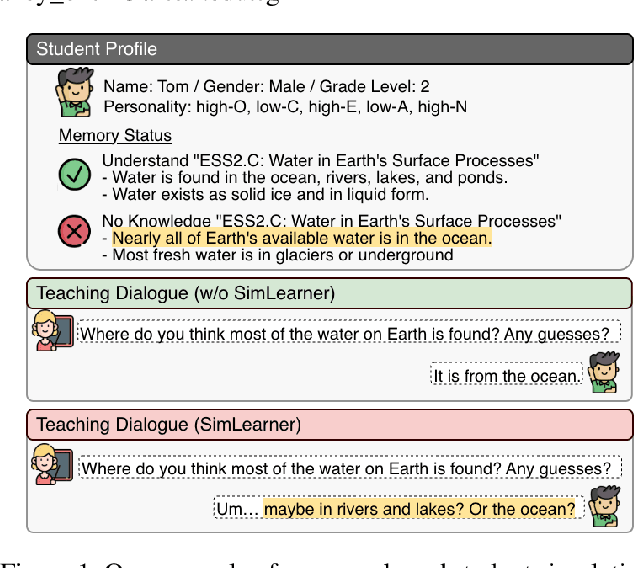
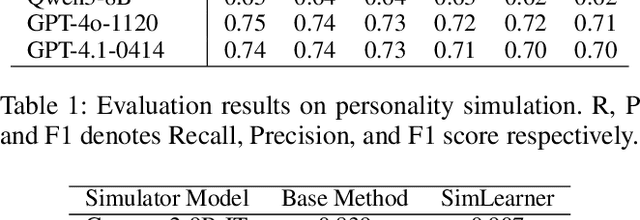


Abstract:User simulation is important for developing and evaluating human-centered AI, yet current student simulation in educational applications has significant limitations. Existing approaches focus on single learning experiences and do not account for students' gradual knowledge construction and evolving skill sets. Moreover, large language models are optimized to produce direct and accurate responses, making it challenging to represent the incomplete understanding and developmental constraints that characterize real learners. In this paper, we introduce a novel framework for memory-based student simulation that incorporates developmental trajectories through a hierarchical memory mechanism with structured knowledge representation. The framework also integrates metacognitive processes and personality traits to enrich the individual learner profiling, through dynamical consolidation of both cognitive development and personal learning characteristics. In practice, we implement a curriculum-aligned simulator grounded on the Next Generation Science Standards. Experimental results show that our approach can effectively reflect the gradual nature of knowledge development and the characteristic difficulties students face, providing a more accurate representation of learning processes.
Patch-as-Decodable-Token: Towards Unified Multi-Modal Vision Tasks in MLLMs
Oct 02, 2025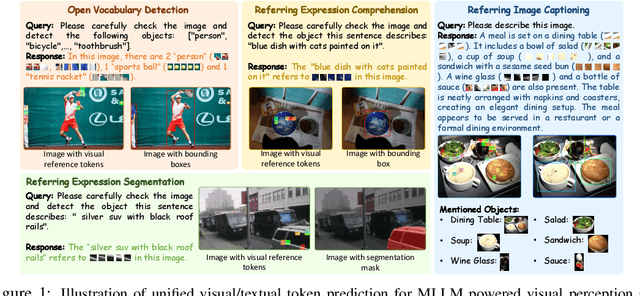
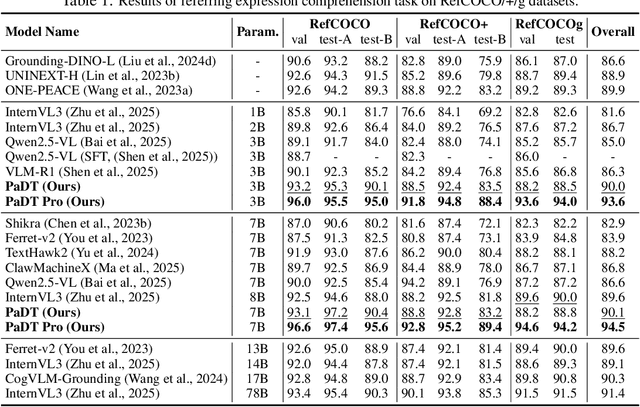
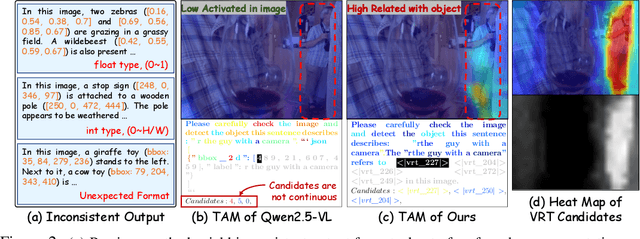
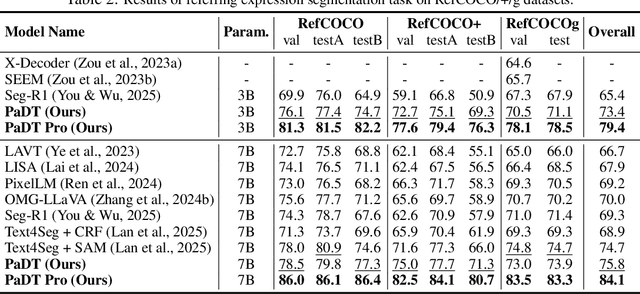
Abstract:Multimodal large language models (MLLMs) have advanced rapidly in recent years. However, existing approaches for vision tasks often rely on indirect representations, such as generating coordinates as text for detection, which limits performance and prevents dense prediction tasks like segmentation. To overcome these challenges, we introduce Patch-as-Decodable Token (PaDT), a unified paradigm that enables MLLMs to directly generate both textual and diverse visual outputs. Central to PaDT are Visual Reference Tokens (VRTs), derived from visual patch embeddings of query images and interleaved seamlessly with LLM's output textual tokens. A lightweight decoder then transforms LLM's outputs into detection, segmentation, and grounding predictions. Unlike prior methods, PaDT processes VRTs independently at each forward pass and dynamically expands the embedding table, thus improving localization and differentiation among similar objects. We further tailor a training strategy for PaDT by randomly selecting VRTs for supervised fine-tuning and introducing a robust per-token cross-entropy loss. Our empirical studies across four visual perception and understanding tasks suggest PaDT consistently achieving state-of-the-art performance, even compared with significantly larger MLLM models. The code is available at https://github.com/Gorilla-Lab-SCUT/PaDT.
Persuasion Dynamics in LLMs: Investigating Robustness and Adaptability in Knowledge and Safety with DuET-PD
Aug 24, 2025Abstract:Large Language Models (LLMs) can struggle to balance gullibility to misinformation and resistance to valid corrections in persuasive dialogues, a critical challenge for reliable deployment. We introduce DuET-PD (Dual Evaluation for Trust in Persuasive Dialogues), a framework evaluating multi-turn stance-change dynamics across dual dimensions: persuasion type (corrective/misleading) and domain (knowledge via MMLU-Pro, and safety via SALAD-Bench). We find that even a state-of-the-art model like GPT-4o achieves only 27.32% accuracy in MMLU-Pro under sustained misleading persuasions. Moreover, results reveal a concerning trend of increasing sycophancy in newer open-source models. To address this, we introduce Holistic DPO, a training approach balancing positive and negative persuasion examples. Unlike prompting or resist-only training, Holistic DPO enhances both robustness to misinformation and receptiveness to corrections, improving Llama-3.1-8B-Instruct's accuracy under misleading persuasion in safety contexts from 4.21% to 76.54%. These contributions offer a pathway to developing more reliable and adaptable LLMs for multi-turn dialogue. Code is available at https://github.com/Social-AI-Studio/DuET-PD.
MultiAiTutor: Child-Friendly Educational Multilingual Speech Generation Tutor with LLMs
Aug 12, 2025Abstract:Generative speech models have demonstrated significant potential in personalizing teacher-student interactions, offering valuable real-world applications for language learning in children's education. However, achieving high-quality, child-friendly speech generation remains challenging, particularly for low-resource languages across diverse languages and cultural contexts. In this paper, we propose MultiAiTutor, an educational multilingual generative AI tutor with child-friendly designs, leveraging LLM architecture for speech generation tailored for educational purposes. We propose to integrate age-appropriate multilingual speech generation using LLM architectures, facilitating young children's language learning through culturally relevant image-description tasks in three low-resource languages: Singaporean-accent Mandarin, Malay, and Tamil. Experimental results from both objective metrics and subjective evaluations demonstrate the superior performance of the proposed MultiAiTutor compared to baseline methods.
A correlation-permutation approach for speech-music encoders model merging
Jun 13, 2025Abstract:Creating a unified speech and music model requires expensive pre-training. Model merging can instead create an unified audio model with minimal computational expense. However, direct merging is challenging when the models are not aligned in the weight space. Motivated by Git Re-Basin, we introduce a correlation-permutation approach that aligns a music encoder's internal layers with a speech encoder. We extend previous work to the case of merging transformer layers. The method computes a permutation matrix that maximizes the model's features-wise cross-correlations layer by layer, enabling effective fusion of these otherwise disjoint models. The merged model retains speech capabilities through this method while significantly enhancing music performance, achieving an improvement of 14.83 points in average score compared to linear interpolation model merging. This work allows the creation of unified audio models from independently trained encoders.
Confidence-Based Self-Training for EMG-to-Speech: Leveraging Synthetic EMG for Robust Modeling
Jun 13, 2025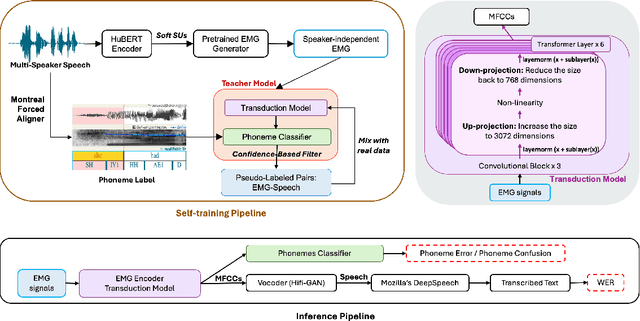
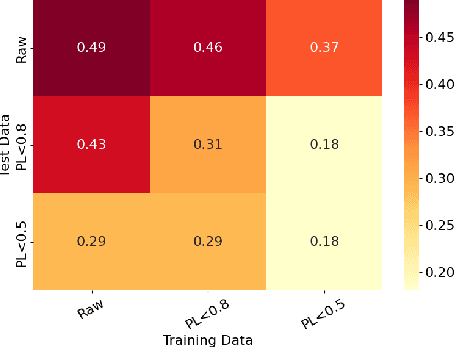
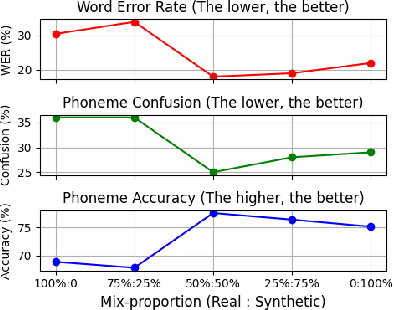

Abstract:Voiced Electromyography (EMG)-to-Speech (V-ETS) models reconstruct speech from muscle activity signals, facilitating applications such as neurolaryngologic diagnostics. Despite its potential, the advancement of V-ETS is hindered by a scarcity of paired EMG-speech data. To address this, we propose a novel Confidence-based Multi-Speaker Self-training (CoM2S) approach, along with a newly curated Libri-EMG dataset. This approach leverages synthetic EMG data generated by a pre-trained model, followed by a proposed filtering mechanism based on phoneme-level confidence to enhance the ETS model through the proposed self-training techniques. Experiments demonstrate our method improves phoneme accuracy, reduces phonological confusion, and lowers word error rate, confirming the effectiveness of our CoM2S approach for V-ETS. In support of future research, we will release the codes and the proposed Libri-EMG dataset-an open-access, time-aligned, multi-speaker voiced EMG and speech recordings.
COGENT: A Curriculum-oriented Framework for Generating Grade-appropriate Educational Content
Jun 11, 2025Abstract:While Generative AI has demonstrated strong potential and versatility in content generation, its application to educational contexts presents several challenges. Models often fail to align with curriculum standards and maintain grade-appropriate reading levels consistently. Furthermore, STEM education poses additional challenges in balancing scientific explanations with everyday language when introducing complex and abstract ideas and phenomena to younger students. In this work, we propose COGENT, a curriculum-oriented framework for generating grade-appropriate educational content. We incorporate three curriculum components (science concepts, core ideas, and learning objectives), control readability through length, vocabulary, and sentence complexity, and adopt a ``wonder-based'' approach to increase student engagement and interest. We conduct a multi-dimensional evaluation via both LLM-as-a-judge and human expert analysis. Experimental results show that COGENT consistently produces grade-appropriate passages that are comparable or superior to human references. Our work establishes a viable approach for scaling adaptive and high-quality learning resources.
Beyond Classification: Towards Speech Emotion Reasoning with Multitask AudioLLMs
Jun 07, 2025Abstract:Audio Large Language Models (AudioLLMs) have achieved strong results in semantic tasks like speech recognition and translation, but remain limited in modeling paralinguistic cues such as emotion. Existing approaches often treat emotion understanding as a classification problem, offering little insight into the underlying rationale behind predictions. In this work, we explore emotion reasoning, a strategy that leverages the generative capabilities of AudioLLMs to enhance emotion recognition by producing semantically aligned, evidence-grounded explanations. To support this in multitask AudioLLMs, we introduce a unified framework combining reasoning-augmented data supervision, dual-encoder architecture, and task-alternating training. This approach enables AudioLLMs to effectively learn different tasks while incorporating emotional reasoning. Experiments on IEMOCAP and MELD show that our approach not only improves emotion prediction accuracy but also enhances the coherence and evidential grounding of the generated responses.
What Makes a Good Natural Language Prompt?
Jun 07, 2025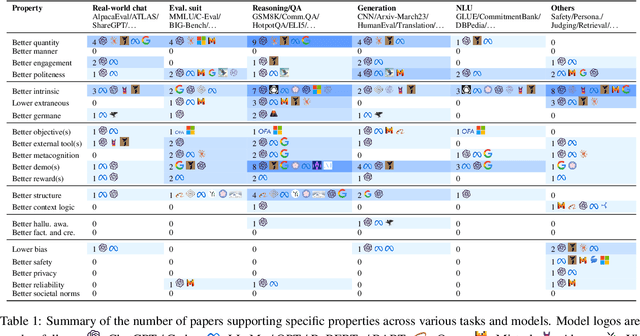
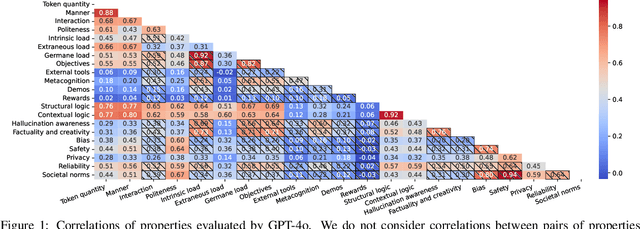
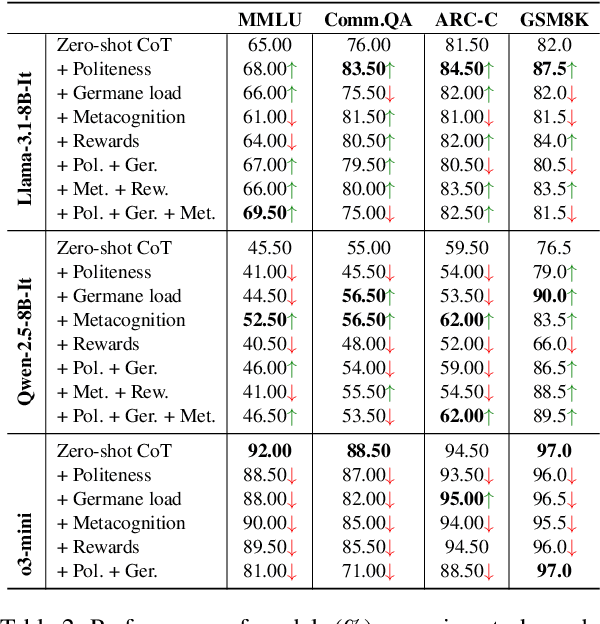

Abstract:As large language models (LLMs) have progressed towards more human-like and human--AI communications have become prevalent, prompting has emerged as a decisive component. However, there is limited conceptual consensus on what exactly quantifies natural language prompts. We attempt to address this question by conducting a meta-analysis surveying more than 150 prompting-related papers from leading NLP and AI conferences from 2022 to 2025 and blogs. We propose a property- and human-centric framework for evaluating prompt quality, encompassing 21 properties categorized into six dimensions. We then examine how existing studies assess their impact on LLMs, revealing their imbalanced support across models and tasks, and substantial research gaps. Further, we analyze correlations among properties in high-quality natural language prompts, deriving prompting recommendations. We then empirically explore multi-property prompt enhancements in reasoning tasks, observing that single-property enhancements often have the greatest impact. Finally, we discover that instruction-tuning on property-enhanced prompts can result in better reasoning models. Our findings establish a foundation for property-centric prompt evaluation and optimization, bridging the gaps between human--AI communication and opening new prompting research directions.
 Add to Chrome
Add to Chrome Add to Firefox
Add to Firefox Add to Edge
Add to Edge